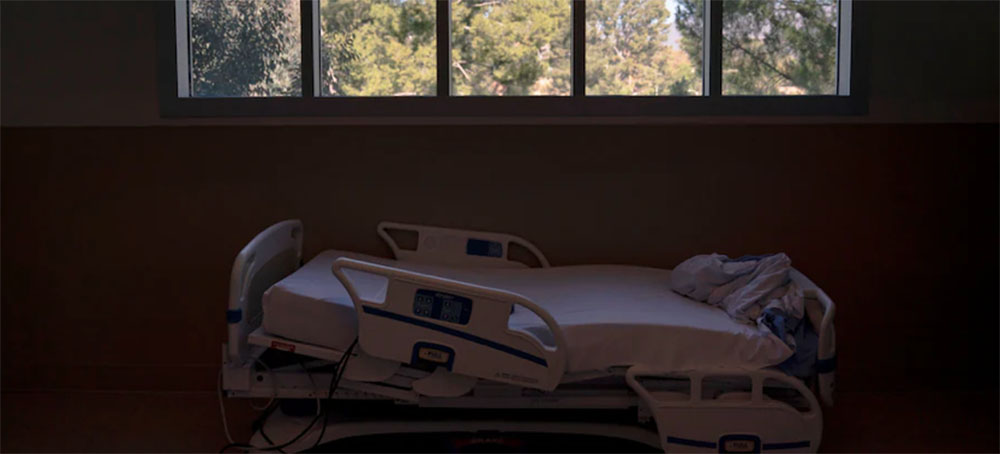The Great Medicaid Purge Begins
Catherine Rampell The Washington Post A hospital bed is seen in a covid-19 unit at Providence Holy Cross Medical Center in Los Angeles in November 2020. (photo: Jae C. Hong/AP)
A hospital bed is seen in a covid-19 unit at Providence Holy Cross Medical Center in Los Angeles in November 2020. (photo: Jae C. Hong/AP)
Starting at midnight Saturday, the first of an expected 15 million people will be kicked off Medicaid and the Children’s Health Insurance Program (CHIP). At least five states — Arizona, Arkansas, Idaho, New Hampshire, South Dakota — have said they will begin terminating coverage throughout the month of April.
Other states have said they will follow. The entire purge, which is completely legal, will take place over a year.
What’s behind this mass disenrollment?
The proximate cause might seem reasonable: The covid-19 public health emergency is no longer forcing states to retain every Medicaid enrollee already on the books.
Early in the pandemic, as a condition of receiving additional federal funding, states were temporarily barred from kicking anyone off Medicaid. This was intended to guarantee more people access to medical care while the coronavirus crisis was raging. Better to err on the side of keeping people insured, lawmakers figured, lest any cash-strapped states find excuses to dump patients to save money. Or maybe states would terminate lots of beneficiaries by accident, amid the chaos of office closures.
Thanks to this federal policy change, Medicaid and CHIP rolls swelled, and the country’s uninsured rate fell to a record low last year. But as covid risks abated, all sorts of emergency safety-net measures, from extra food stamps to free covid vaccinations, have been phased out. Everyone knew that, at some point, the relaxed Medicaid regulations would likely sunset, too.
That sunset begins this Saturday. As a result, a lot of Americans are about to fall through the cracks of our haphazard health-insurance system, and become uninsured altogether.
In fact, many will become uninsured even if they still legally qualify for Medicaid!
According to government estimates, nearly half the people expected to get purged from Medicaid (6.8 million) will still be eligible for Medicaid. Among children, the share is even higher: 72 percent of children expected to lose their Medicaid or CHIP coverage will technically still be eligible for Medicaid or CHIP.
The degree of government failure here should be considered scandalous. To be clear: These people are not losing insurance because their incomes rose, or they aged out of a given program. Rather, they’re losing coverage for pointless bureaucratic reasons. Maybe a letter got sent to the wrong address. Or a beneficiary had difficulty with a broken government website.
Unfortunately, this red tape is the same reason why lots of eligible families get purged even in a normal, non-end-of-pandemic year. As aberrant as the current “Medicaid unwinding” might appear, it obscures a problem that has long ailed U.S. government programs at virtually all levels: how little federal and state policymakers have done to guarantee access to critical, promised safety-net benefits.
Depending on the state, proving and re-proving eligibility for Medicaid (or food stamps, or other programs) can be somewhere between cumbersome and impossible. In some parts of the country, this is deliberate: Government-hating politicians want fewer poor people to get benefits. Rather than changing eligibility requirements (which courts don’t always favor), officials set up an obstacle course and hope some people get tripped up.
In other states, public officials truly want everyone eligible for benefits to successfully receive them. But vulnerable families fall through the cracks anyway, often because of poor management or bad government IT.
Over the past year, the federal government has been working with states to limit the number of people who will lose coverage when those pandemic-era Medicaid “continuous enrollment” provisions end. States have done more outreach, for example, to help people reapply to Medicaid or switch to different forms of coverage. And to some extent, states are trying to auto-renew more Medicaid recipients, by analyzing the internal data sources governments already have handy (such as payroll tax records) to confirm someone remains eligible.
But one legitimate question is why more states haven’t been doing this already.
For roughly a decade, Obamacare regulations have required states to do these kinds of auto-renewals based on existing internal data (called “ex parte” renewals), as well as other measures to make applications more accessible to the public. Most states, though, are not in compliance with those long-standing federal requirements, says Tricia Brooks, a researcher at Georgetown. For example, only 11 states complete most of their renewals using ex parte processes, according to the Kaiser Family Foundation. And states face little to no consequences for their failure.
States must do better. More of the burden of enrolling for government services should be on government, not on the vulnerable families the government is supposed to help. The tragedy of the Great Medicaid Purge is not, as it might seem, a one-off, acute ailment; this red tape is a chronic illness, one that governments should have been treating long before covid began.



